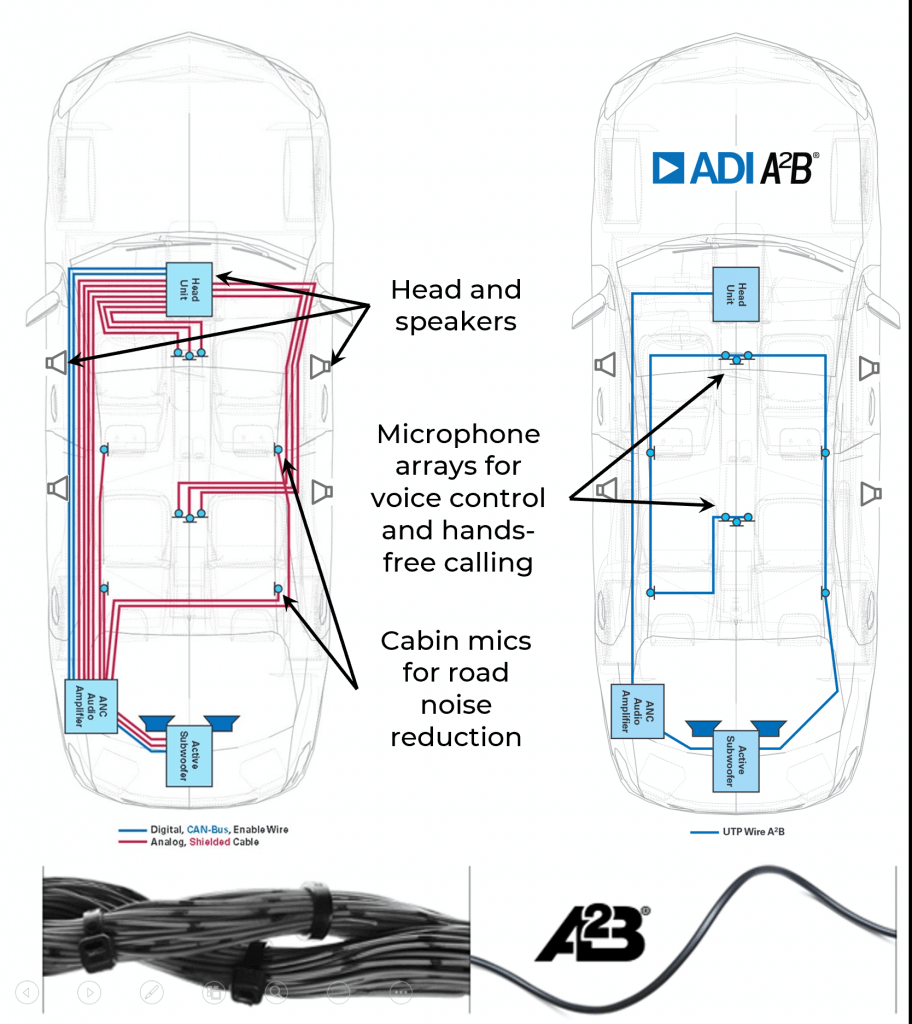In today’s world of business, ongoing innovation cannot take a back seat. As experts in connected product design, we’re always striving to consider and develop potential new applications for the technologies we work with in order to help our clients bring the best possible products to market.
One such technology is our partner Analog Devices‘ Automotive Audio Bus® (A2B) digital audio bus technology.
In part one of this two-part blog series, we’ll delve into how the technology works, the advantages of employing the technology and its use in automotive applications. Part two will see us explore potential new applications for Analog Devices’ digital audio bus technology.
Contents
Using ADI’s A2B in Automotive Applications
In automotive design, there’s a delicate balance between the removal and addition of features. While weight, complexity and added costs need to be taken out, car manufacturers — and millions of drivers — increasingly expect their cars to come equipped with an advanced, feature-rich infotainment experience. From voice recognition and in-car communications to active noise cancellation and improved gas mileage, the user experience is increasingly taking priority in automotive design.
In order to help solve this challenge, Analog Devices (aka ADI) developed the A2B digital audio bus. This technology delivers high-fidelity audio for automobiles, implementations of which traditionally required a large amount of expensive, heavy cabling. But now, A2B transceivers are capable of distributing audio and control data together with clock and power over a single, low-cost, unshielded twisted-pair (UTP) wire.
The A2B audio bus connects multiple remote sensors for different applications in a daisy-chain sequence, significantly reducing heavy analog cabling runs and the weight of existing cable harnesses (by upwards of 75% in key applications), which results in improved vehicle fuel efficiency, as well as overall design costs and complexity. The technology also allows expanded use cases for microphone connectivity and is ideal for emerging multi-mic applications, such as road noise cancellation, in-car communications and autonomous driving.
The final result? Greener cars, with superior features and better designs. But how does the technology actually work?

How Analog Devices’ Automotive Audio Bus (A2B) Bus Works
An extremely new — and not-very-well-known — multidrop bus, A2B allows audio to be routed to multiple devices across one medium.
In computer architecture, a bus is a communications transport that has many entry and exit points to transfer data inside or between computers. Capable of transporting I2S/TDM/PDM data and I2C control information, along with clock and power, using a single, two-wire UTP cable over distances up to 15 meters between nodes and 40 meters over the entire daisy chain, A2B can be used as its own network, with embedded sub-networks, or as an endpoint transport bus used in combination with other, longer-distance protocols.
With extremely low, predictable delay and next to zero or zero jitter, A2B offers a number of advantages over alternative technologies.
By using the same development tool that supports the Analog Devices SigmaDSP(r) and SHARC(r) processor families, the design of an A2B-enabled system is simple due to the graphical design environment’s configurable, flexible, low-risk and easy-to-use nature.
As previously mentioned, A2B reduces system complexity and cable costs. The technology’s ability to provide power to remote nodes over the same UTP cable used to transport data removes the need for a local power supply on each bus-powered secondary node, ultimately reducing the system’s overall bill of materials (BOM) costs, weight and complexity.
Plus, by ensuring simultaneous sampling and delivery of data on all system nodes for each frame, A2B technology delivers deterministic and very low, sub-50 microsecond (µs) latency. Ideal for transporting digital audio, A2B features a configurable 44.1 kHz or 48 kHz frame rate and up to a 50 Mbps bandwidth to deliver truly superior audio quality relative to analog connections.
ADI has decided to release the technology to the wide market by incorporating it into some of their processor chips, but given it costs something like $25 million to make a new chip, we have been somewhat surprised by the lack of adoption for different applications across other markets as the technology addresses a range of common engineering challenges.
That’s where Cardinal Peak comes in. We encourage you to reach out to our A2B experts to learn more about developing A2B solutions across industries and applications.
For background and additional information, check out our other articles on A2B technology:
- How Does A2B Work and Where Has Cardinal Peak Used It?
- Unleashing A2B Technology For Conferencing, Live Audio And Other Applications
- The Future Of Fault Detection: A2B Technology For Automated Equipment
- Designing Audio Products with A2B and SHARC
- Taking Analog Devices A2B Technology Beyond Automotive Applications
- From GPTP To Buffer Overflow: Ensuring Seamless Automotive Audio
- Cardinal Peak Named Analog Devices Design Partner
